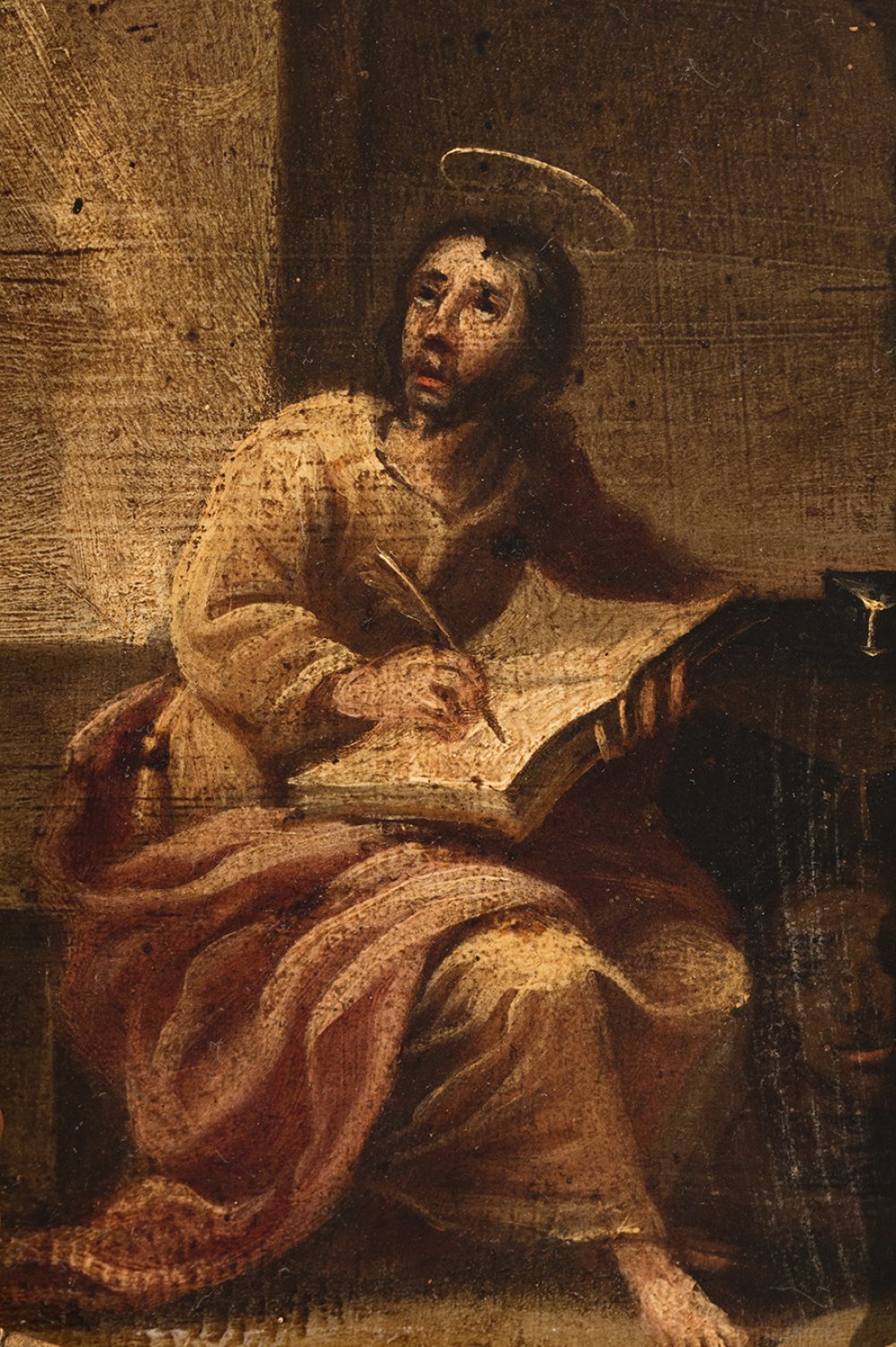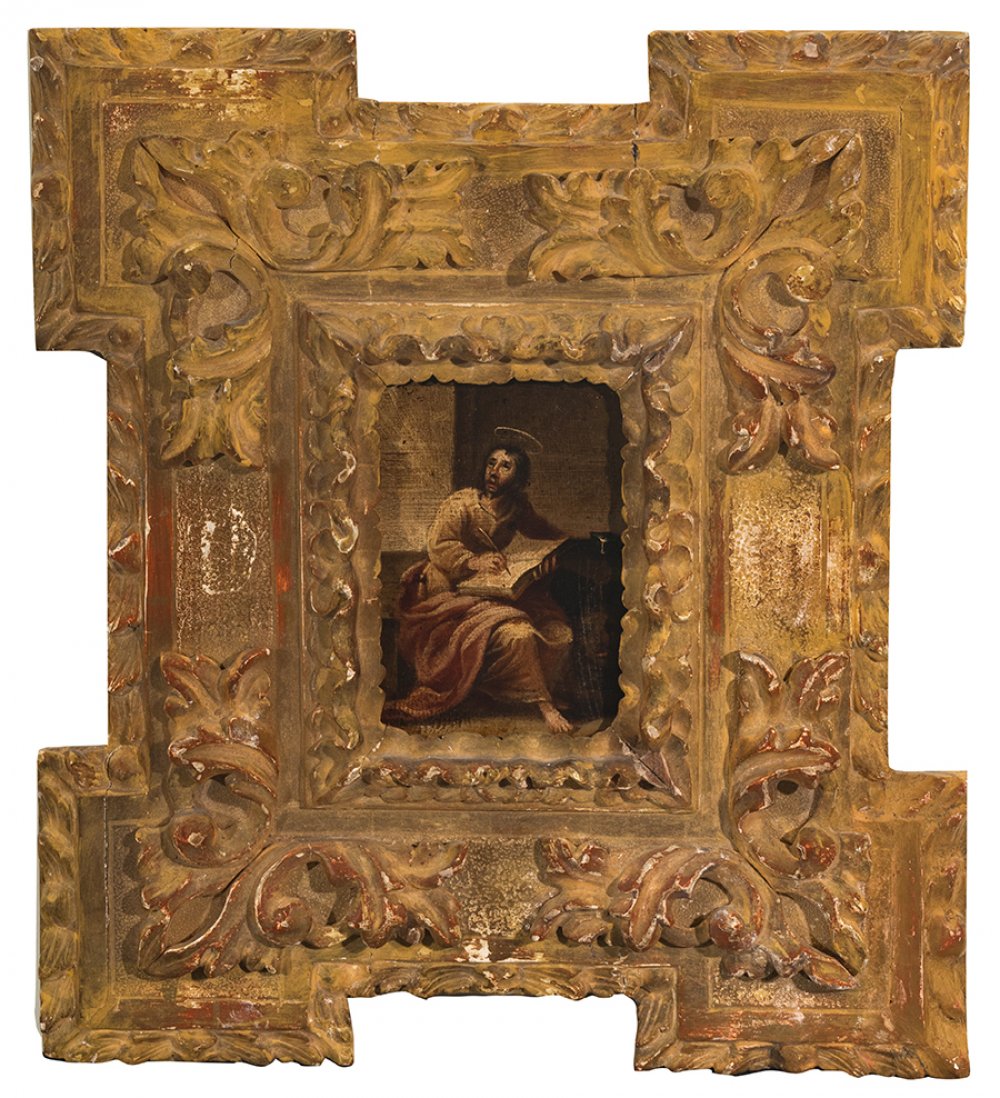26
Sevillian school, second half of the 17th century."Saint John of Patmos".Oil on panel.
"Saint John of Patmos".
Oil on panel.
Measurements: 10 x 11.5 cm; 41 x 36 cm (frame).
In this work the author gathers a religious story, in which one of the main parts of the Apocalypse of St. John is narrated, which gathers the revelations that the Evangelist had in Patmos. The text of Revelation states that John was on Patmos, a Greek island where, according to most biblical historians, he is considered to have been exiled as a result of anti-Christian persecution under the Roman Emperor Domitian. It was in a cave where he heard a voice "as of a trumpet" (Book of Revelation:10). When he turned around, he saw the figure of the Son of Man. However, this image does not show the visions that are recorded in the Book of Revelation, also known as the Book of Revelation. The most poetic and conceptual of the four evangelists, John the Evangelist is often assimilated to the figure of the "beloved disciple", and writings tell us that after the martyrdom of Peter and Paul he settled in Ephesus. Tradition has it that he was taken to Rome, where the Emperor Domitian ordered him to be burned with boiling oil. He is not considered a martyred apostle according to tradition, as he was saved from martyrdom and banished to the island of Patmos, where he wrote the Apocalypse. Saint John the Evangelist is one of the figures who appears most frequently in the narratives and plastic representations of the Passion of Christ. He is often depicted at the foot of the cross next to the Virgin, and it was he who laid his head on Jesus' chest at the Last Supper, when the name of the disciple who was to betray his master was revealed to him.
The 17th century saw the arrival of the Baroque in the Sevillian school, with the triumph of naturalism over Mannerist idealism, a loose style and many other aesthetic liberties. At this time the school reached its greatest splendour, both in terms of the quality of its works and the primordial status of Sevillian Baroque painting. Thus, during the transition to the Baroque period, we find Juan del Castillo, Antonio Mohedano and Francisco Herrera el Viejo, whose works already display the rapid brushstrokes and crude realism of the style, and Juan de Roelas, who introduced Venetian colourism. The middle of the century saw the fullness of the period, with figures such as Zurbarán, a young Alonso Cano and Velázquez. Finally, in the last third of the century we find Murillo and Valdés Leal, founders in 1660 of an Academy where many of the painters active during the first quarter of the 18th century were trained, such as Meneses Osorio, Sebastián Gómez, Lucas Valdés and others.
"Saint John of Patmos".
Oil on panel.
Measurements: 10 x 11.5 cm; 41 x 36 cm (frame).
In this work the author gathers a religious story, in which one of the main parts of the Apocalypse of St. John is narrated, which gathers the revelations that the Evangelist had in Patmos. The text of Revelation states that John was on Patmos, a Greek island where, according to most biblical historians, he is considered to have been exiled as a result of anti-Christian persecution under the Roman Emperor Domitian. It was in a cave where he heard a voice "as of a trumpet" (Book of Revelation:10). When he turned around, he saw the figure of the Son of Man. However, this image does not show the visions that are recorded in the Book of Revelation, also known as the Book of Revelation. The most poetic and conceptual of the four evangelists, John the Evangelist is often assimilated to the figure of the "beloved disciple", and writings tell us that after the martyrdom of Peter and Paul he settled in Ephesus. Tradition has it that he was taken to Rome, where the Emperor Domitian ordered him to be burned with boiling oil. He is not considered a martyred apostle according to tradition, as he was saved from martyrdom and banished to the island of Patmos, where he wrote the Apocalypse. Saint John the Evangelist is one of the figures who appears most frequently in the narratives and plastic representations of the Passion of Christ. He is often depicted at the foot of the cross next to the Virgin, and it was he who laid his head on Jesus' chest at the Last Supper, when the name of the disciple who was to betray his master was revealed to him.
The 17th century saw the arrival of the Baroque in the Sevillian school, with the triumph of naturalism over Mannerist idealism, a loose style and many other aesthetic liberties. At this time the school reached its greatest splendour, both in terms of the quality of its works and the primordial status of Sevillian Baroque painting. Thus, during the transition to the Baroque period, we find Juan del Castillo, Antonio Mohedano and Francisco Herrera el Viejo, whose works already display the rapid brushstrokes and crude realism of the style, and Juan de Roelas, who introduced Venetian colourism. The middle of the century saw the fullness of the period, with figures such as Zurbarán, a young Alonso Cano and Velázquez. Finally, in the last third of the century we find Murillo and Valdés Leal, founders in 1660 of an Academy where many of the painters active during the first quarter of the 18th century were trained, such as Meneses Osorio, Sebastián Gómez, Lucas Valdés and others.
22nd November - Old Masters
Sale Date(s)
Venue Address
General delivery information available from the auctioneer
Setdart offers Worldwide shipping
PICK UP IN ROOM: You can come and pick up your lots in our offices (Barcelona, Madrid or Valencia). At the moment of the withdrawal, you will be able to accept the current conditions of the lot by means of a document that you will sign.
YOU CAN SEND ANOTHER PERSON TO PICK UP: This person must present a signed authorization that you can find in our web page by accessing from BUY AT SETDART- LOGISTICS-DOWNLOAD AUTHORIZATION DOCUMENT. You can also send an e-mail with the requested data in AUTHORIZATION DOCUMENT to admin@setdart.com
Important Information
25% buyer´s premium
Terms & Conditions
The maximum period to pay the lots is 7 working days. You can pay either via bank transfer or with credit card through our platform www.setdart.com (we only accept VISA or Mastercard).
BUYER´S PREMIUM: 22% Hammer price + 21% VAT from the buyer´s premium
If your piece has more than 100 years, our Ministry of Culture requires an export certificate in order for the piece to leave the country. Note that if the piece goes inside the EU, there is no cost for the export certificate. If the piece goes outside the EU, there is a cost for the export certificate. You can find more information in our Ministry of Culture website: https://www.culturaydeporte.gob.es/en/cultura/patrimonio/exportacionimportacion/exportacion/tasas.html
INQUIRIES: admin@setdart.com
Setdart guides you through the entire process, from the time of award to the day you receive your lot. Our logistics team will be happy to manage your transport, and will advise you on the best shipping method with professionals from the sector used to handling works of art and jewelry.
WE OFFER WORLDWIDE DOOR TO DOOR SHIPPING
PICK UP IN ROOM: You can come and pick up your lots in our offices. At the moment of the withdrawal, you will be able to accept the current conditions of the lot by means of a document that you will sign.
YOU CAN SEND ANOTHER PERSON TO PICK UP: This person must present a signed authorization that you can find in our web page by accessing from BUY AT SETDART-LOGISTICS-DOWNLOAD AUTHORIZATION DOCUMENT. You can also send an e-mail with the requested data in AUTHORIZATION DOCUMENT to admin@setdart.com
SETDART IS NOT RESPONSIBLE FOR THE STATE OF THE PARTS ONCE THEY LEAVE OUR FACILITIES. MRW SHIPMENTS: Once the payment is made, your lot will be packed for shipment, the logistics department will send you an e-mail notifying you of the day it leaves our warehouse, changes of address cannot be made after receiving this e-mail.
INSURANCE INCIDENTS: Coverage for the value of the auction up to 3000 ? per shipment, if the value of the auction is higher, Setdart will send you a quote including the additional insurance. The insurance company WILL NOT BE RESPONSIBLE FOR THE SHIPMENT THAT EXCEEDS THAT AMOUNT AND IS NOT FULLY INSURED. MRW INCIDENTS: Maximum notification 48 hours after receipt, after which the insurance company WILL NOT BE RESPONSIBLE AND NO CLAIMS WILL BE ACCEPTED.
E-MAIL LOGISTICS: logistica@setdart.com
PICK UP YOUR MESSAGES: You can send your own messaging, prior notice via e-mail that your shipment is ready, please note 3 or 4 days in advance. This type of shipment is packaged so Setdart will provide you with a quote.
EXPENSES FOR STORAGE: We inform you that if the purchased lot is not picked up within a month, you will be charged 30€ per week per lot. Setdart Online S.L., owner of the web site "setdart.com", "setdart.net" and "setdart.org", acts as a company of Spanish nationality inscribed in the Volume 36955, sheet 182, page B-293056 of the Mercantile Registry, with registered office at Calle Aragó









